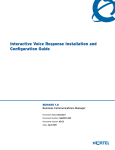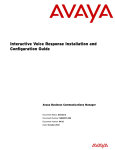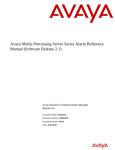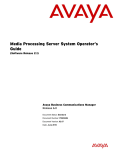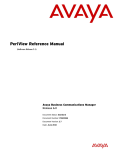Download Avaya IVR Configuration Guide
Transcript
Part No. P0606198 02 23 March 2004 Interactive Voice Response Installation and Configuration Guide 2 Interactive Voice Response Installation and Configuration Guide Copyright © 2004 Nortel Networks All rights reserved. 2004. The information in this document is subject to change without notice. The statements, configurations, technical data, and recommendations in this document are believed to be accurate and reliable, but are presented without express or implied warranty. Users must take full responsibility for their applications of any products specified in this document. The information in this document is proprietary to Nortel Networks NA Inc. The software described in this document is furnished under a license agreement and may be used only in accordance with the terms of that license. The software license agreement is included in this document. Trademarks NORTEL NETWORKS is a trademark of Nortel Networks. Microsoft, MS, MS-DOS, Windows, and Windows NT are registered trademarks of Microsoft Corporation. All other trademarks and registered trademarks are the property of their respective owners. P0606198 02 3 Contents Chapter 1 About Interactive Voice Response . . . . . . . . . . . . . . . . . . . . . . . . . . . . . . . . . 5 What you need to know . . . . . . . . . . . . . . . . . . . . . . . . . . . . . . . . . . . . . . . . . . . . . . . . . Hardware and software requirements . . . . . . . . . . . . . . . . . . . . . . . . . . . . . . . . . . . . . . Interactive Voice Response capacities . . . . . . . . . . . . . . . . . . . . . . . . . . . . . . . . . . . . . How to get help . . . . . . . . . . . . . . . . . . . . . . . . . . . . . . . . . . . . . . . . . . . . . . . . . . . . . . . 5 5 6 7 Chapter 2 Installing Interactive Voice Response . . . . . . . . . . . . . . . . . . . . . . . . . . . . . . 9 Overview of installing Interactive Voice Response . . . . . . . . . . . . . . . . . . . . . . . . . . . . 9 Enabling the Interactive Voice Response software authorization code . . . . . . . . . . . . 11 Making Interactive Voice Response an automatic service . . . . . . . . . . . . . . . . . . . . . . 12 Administering several Interactive Voice Response systems . . . . . . . . . . . . . . . . . . . . 13 About Installing PeriView . . . . . . . . . . . . . . . . . . . . . . . . . . . . . . . . . . . . . . . . . . . . . . . 14 Before you install PeriView . . . . . . . . . . . . . . . . . . . . . . . . . . . . . . . . . . . . . . . . . . 14 To install PeriView . . . . . . . . . . . . . . . . . . . . . . . . . . . . . . . . . . . . . . . . . . . . . . . . . 15 Adjusting the number of voice ports . . . . . . . . . . . . . . . . . . . . . . . . . . . . . . . . . . . . . . 24 Uploading Interactive Voice Response prompts . . . . . . . . . . . . . . . . . . . . . . . . . . . . . 26 Installing the client database software . . . . . . . . . . . . . . . . . . . . . . . . . . . . . . . . . . . . . 27 Databases supported on Business Communications Manager . . . . . . . . . . . . . . 28 Configuring host access . . . . . . . . . . . . . . . . . . . . . . . . . . . . . . . . . . . . . . . . . . . . . . . 29 Enabling the Host Communication Access Keycode . . . . . . . . . . . . . . . . . . . . . . . 29 Using PeriView to load and configure scripts . . . . . . . . . . . . . . . . . . . . . . . . . . . . . . . 36 Dialing the Interactive Voice Response extension . . . . . . . . . . . . . . . . . . . . . . . . . . . . 41 Assigning lines to Interactive Voice Response . . . . . . . . . . . . . . . . . . . . . . . . . . . . . . 42 Viewing or changing the system fax name . . . . . . . . . . . . . . . . . . . . . . . . . . . . . . . . . 44 Chapter 3 Administering Interactive Voice Response . . . . . . . . . . . . . . . . . . . . . . . . . 45 Stopping, starting or restarting Interactive Voice Response service . . . . . . . . . . . . . . Changing how Interactive Voice Response service operates after a reboot . . . . . . . . Backing up and restoring Interactive Voice Response . . . . . . . . . . . . . . . . . . . . . . . . Creating Interactive Voice Response logs . . . . . . . . . . . . . . . . . . . . . . . . . . . . . . . . . . Uninstalling PeriView . . . . . . . . . . . . . . . . . . . . . . . . . . . . . . . . . . . . . . . . . . . . . . . . . . Considerations for uninstalling PeriView . . . . . . . . . . . . . . . . . . . . . . . . . . . . . . . . Uninstalling the patch bundle . . . . . . . . . . . . . . . . . . . . . . . . . . . . . . . . . . . . . . . . Uninstalling packages using PERIinstaller . . . . . . . . . . . . . . . . . . . . . . . . . . . . . . Removing additional files and directories . . . . . . . . . . . . . . . . . . . . . . . . . . . . . . . Removing the environment variables . . . . . . . . . . . . . . . . . . . . . . . . . . . . . . . . . . Removing Interactive Voice Response, XVision and JRE . . . . . . . . . . . . . . . . . . . Creating reports . . . . . . . . . . . . . . . . . . . . . . . . . . . . . . . . . . . . . . . . . . . . . . . . . . . . . . 46 47 48 49 52 52 52 52 53 54 55 55 Chapter 4 Troubleshooting. . . . . . . . . . . . . . . . . . . . . . . . . . . . . . . . . . . . . . . . . . . . . . . 57 Index . . . . . . . . . . . . . . . . . . . . . . . . . . . . . . . . . . . . . . . . . . . . . . . . . . . . . . . . 61 Interactive Voice Response Installation and Configuration Guide 4 Contents P0606198 02 5 Chapter 1 About Interactive Voice Response This guide leads a system administrator through installing and configuring Interactive Voice Response on a Business Communications Manager system. Interactive Voice Response is an automated telephony application that prompts callers with a combination of recorded menus and prompts, and real-time data from databases. Users enter digits from their touch tone key pad that directs the Interactive Voice Response application to access databases and play information back to the caller. Interactive Voice Response is a call-handling system that frees up employees to perform their jobs, and agents to make sales, rather than answer frequently asked questions. Interactive Voice Response, can distribute calls, make announcements, and give callers access to relevant information from dynamic databases 24 hours a day, 7 days a week. This chapter contains • What you need to know • Hardware and software requirements • Interactive Voice Response capacities • How to get help What you need to know To install Interactive Voice Response you must know: • how to log on to Unified Manager and use the Unified Manager interface. Refer to the Business Communications Manager Programming Operations Guide for more information. • how to log on to CallPilot Manager and use the CallPilot Manager interface. Refer to the CallPilot Manager Set Up and Operation Guide for more information. • how to use PeriView. Refer to your PeriView system documentation for more information. • how to create shared network folders. Refer to your Windows documentation for more information. Hardware and software requirements • To install PeriView you must have a computer that runs Windows NT with Service Pack 6. • You must have an Interactive Voice Response keycode. • You must have one Client Administration Software License for the Business Communications Manager that you use to perform administration using PeriView. You need one license per system, not per Business Communications Manager. Interactive Voice Response Installation and Configuration Guide 6 Chapter 1 About Interactive Voice Response Interactive Voice Response capacities Maximum simultaneous calls 24 (24 voice ports) Maximum voice ports 32 Maximum voice ports that can be allocated to voicemail 16 Maximum Interactive Voice Response fax calls 2 Maximum fax ports 2 Recording time available on Business Communications Manager for all applications (Interactive Voice Response, CallPilot and Call Center) 20 Gb disk: 325 hours There are other restrictions that can alter the real number of Voice Ports available on a Business Communications Manager. For more information, refer to the Business Communications Manager Programming Operations Guide, “Configuring the MSC Resources”. Voice Ports cannot be shared between voicemail, Call Center and Interactive Voice Response. P0606198 02 Chapter 1 About Interactive Voice Response 7 How to get help USA and Canada Authorized Distributors - Technical Support Telephone: 1-800-4NORTEL (1-800-466-7835) If you already have a PIN Code, you can enter Express Routing Code (ERC) 196#. If you do not yet have a PIN Code, or for general questions and first line support, you can enter ERC 338#. Website: http://www.nortelnetworks.com/support email: [email protected] Presales Support (CSAN) Telephone: 1-800-4NORTEL (1-800-466-7835) Use Express Routing Code (ERC) 1063# EMEA (Europe, Middle East, Africa) Technical Support Telephone: 00800 800 89009 Fax: 44-191-555-7980 email: [email protected] CALA (Caribbean & Latin America) Technical Support Telephone: 1-954-858-7777 email: [email protected] APAC (Asia Pacific) Technical Support Telephone: +61 388664627 Fax: +61 388664644 email: [email protected] Interactive Voice Response Installation and Configuration Guide 8 Chapter 1 About Interactive Voice Response P0606198 02 9 Chapter 2 Installing Interactive Voice Response This chapter contains: • Overview of installing Interactive Voice Response • Enabling the Interactive Voice Response software authorization code • Making Interactive Voice Response an automatic service • Administering several Interactive Voice Response systems • About Installing PeriView • • Before you install PeriView To install PeriView • Adjusting the number of voice ports • Uploading Interactive Voice Response prompts • Installing the client database software • • Databases supported on Business Communications Manager Configuring host access • Enabling the Host Communication Access Keycode • Using PeriView to load and configure scripts • Dialing the Interactive Voice Response extension • Assigning lines to Interactive Voice Response Overview of installing Interactive Voice Response To install Interactive Voice Response you: 1 Enable the Interactive Voice Response software authorization code. Refer to “Enabling the Interactive Voice Response software authorization code” on page 11. 2 Make sure you have a Client Administration Software License for the BCM that you use to perform administration using PeriView. 3 Make Interactive Voice Response an automatic service. Refer to “Making Interactive Voice Response an automatic service” on page 12. 4 If you are going to use Interactive Voice Response in a multi-node environment, refer to “Administering several Interactive Voice Response systems” on page 13. 5 Install PeriView on a Windows NT client PC. Refer to “About Installing PeriView” on page 14. 6 Assign Voice Ports to Interactive Voice Response. Refer to “Adjusting the number of voice ports” on page 24. Interactive Voice Response Installation and Configuration Guide 10 Chapter 2 Installing Interactive Voice Response 7 Upload the Interactive Voice Response prompts to Business Communications Manager. Refer to “Uploading Interactive Voice Response prompts” on page 26. 8 Install the Client Database software using the appropriate method if your Interactive Voice Response scripts use database access. Refer to “Installing the client database software” on page 27. 9 Configure host access if your Interactive Voice Response scripts use host access. Refer to “Configuring host access” on page 29. 10 Use PeriView’s Application Manager to load and configure the scripts. Refer to “Using PeriView to load and configure scripts” on page 36 and see the PeriView User’s Guide for more details. 11 Verify Interactive Voice Response is working by dialing the Interactive Voice Response extension. Refer to “Dialing the Interactive Voice Response extension” on page 41. 12 Using CallPilot Manager, assign the lines you want the Interactive Voice Response scripts to answer. Refer to “Assigning lines to Interactive Voice Response” on page 42. 13 Back up Interactive Voice Response. Refer to “Backing up and restoring Interactive Voice Response” on page 48. P0606198 02 Chapter 2 Installing Interactive Voice Response 11 Enabling the Interactive Voice Response software authorization code You enable Interactive Voice Response by enabling the Interactive Voice Response software authorization code on the Business Communications Manager Unified Manager. To enable a software authorization code 1 Point your web browser to the URL http://<xxxx>:6800 where <xxxx> is the domain name or IP address of Business Communications Manager. The Business Communications Manager Unified Manager screen appears. 2 Click the Configure button. The Login screen appears. 3 In the User ID and Password boxes enter your system administrator user ID and password, and click the Login button. The Unified Manager screen appears. 4 Click the System key. 5 Click the Licensing heading. The Licensing Setting screen appears. 6 On the Configuration menu click Add a Keycode. The Applied Keycodes screen appears. 7 In the Keycode box type the number of the Interactive Voice Response software authorization code. 8 Click the Save button. A message appears that says you must reboot. Do not reboot your system at this time. 9 Go to “Making Interactive Voice Response an automatic service” on page 12. Interactive Voice Response Installation and Configuration Guide 12 Chapter 2 Installing Interactive Voice Response Making Interactive Voice Response an automatic service 1 On Unified Manager, click the Diagnostics key. 2 Click the Service Manager heading. The Services List screen appears. 3 In the Display Name column select Nortel Networks IVR. 4 On the Configuration menu click Modify Service. The Services List dialog box appears. 5 From the Startup list box select Automatic. 6 Click the Save button. 7 Log off and reboot the system. Interactive Voice Response will start automatically after you reboot. P0606198 02 Chapter 2 Installing Interactive Voice Response 13 Administering several Interactive Voice Response systems If you want to use PeriView to administer several Interactive Voice Response systems on different Business Communications Managers, you must assign a different node number to each Interactive Voice Response system. To change the node number 1 Log on to Unified Manager. 2 Click the Services key. 3 Click the IVR heading. The Summary page displays the version, status of the service and the server number. The node number is 1 by default. The node number can be between 1 and 5000. 4 Press the Tab key to exit from this box. A message appears that says that the Interactive Voice Response service will be temporarily stopped. 5 Click the OK button. 6 You must next install PeriView. Go to “About Installing PeriView” on page 14. Interactive Voice Response Installation and Configuration Guide 14 Chapter 2 Installing Interactive Voice Response About Installing PeriView PeriView is the Interactive Voice Response administrative client. You use PeriView to administer Interactive Voice Response scripts on Business Communications Manager. Before you can use PeriView, you must install it on a client computer. Before you install PeriView • Make sure you install PeriView on a Windows NT PC. PeriView can be installed on Windows NT only. • Make sure you have administrative privileges so that you can install services and update environment settings. • Remove any versions of Perl currently installed on the workstation. PeriView uses a version of Perl specifically designed to work with PeriView. You must remove any other versions of Perl due to potential incompatibility with PeriView. • Quit all active applications and Nortel Networks or Periphonics services. • If Windows NT Service Pack 6A is already installed on your system and you are running the Windows Desktop Update option (Active Desktop), deactivate this option. See the Windows NT online help for instructions. Active Desktop affects color renditions in PeriView. P0606198 02 Chapter 2 Installing Interactive Voice Response 15 To install PeriView 1. Set up the environment variables 1 Click the Windows Start button, point to Settings, point to Control Panel and click System. The System Properties page appears. 2 Click the Environment tab. 3 In the System Variables list, select any variable. The information for the variable is displayed in the Variable and Value boxes. 4 Delete the information the Variable box, and type VPSHOME. 5 Delete the information in the Value box, and type the path where you want the PeriView software to be installed. 6 Click the Set button. The Apply button becomes available. 7 Click the Apply button. 8 In the System Variables list, select any variable. The information for the variable is displayed in the Variable and Value boxes. 9 Delete the information the Variable box, and type ASEHOME. 10 Delete the information in the Value box, and type %VPSHOME%\PERIase. 11 Click the Set button. The Apply button becomes available. Interactive Voice Response Installation and Configuration Guide 16 Chapter 2 Installing Interactive Voice Response 12 Click the Apply button. 13 In the System Variables list, select any variable. The information for the variable is displayed in the Variable and Value boxes. 14 Delete the information the Variable box, and type PERL5LIB. 15 Delete the information in the Value box and type %VPSHOME%\bin. 16 Click the Set button. The Apply button becomes available. 17 Click the Apply button. 18 In the System Variables list, select any variable. The information for the variable is displayed in the Variable and Value boxes. 19 Delete the information the Variable box, and type MAX_REAL_VPS_NUM. 20 Delete the information in the Value box and type 5000. 21 Click the Set button. The Apply button becomes available. 22 Click the Apply button. 23 In the System Variables list select the PATH system variable. The information for the variable is displayed in the Variable and Value boxes. 24 Put your cursor in the Variable box and go to the end of the text string. 25 Make sure the text string ends with a semicolon. It you do not see a semicolon, type one. 26 After the semicolon, type %VPSHOME%\bin. 27 Click the Set button. 28 Click the Apply button. 29 Reboot the computer. P0606198 02 Chapter 2 Installing Interactive Voice Response 17 2. Download the PeriView client software 1 On the client computer, point the web browser to the URL http://<xxxx>:6800 where <xxxx> is the domain name or IP address of Business Communications Manager. The Business Communications Manager Unified Manager screen appears. 2 Click the Install Clients button. The Download Client Applications page appears. Interactive Voice Response Installation and Configuration Guide 18 Chapter 2 Installing Interactive Voice Response 3 In the left frame, under the IVR Applications heading, click the PeriView link. The PeriView Client page appears. 4 Click the Download PeriView Client button. 5 Navigate to where you want to download the file to. We recommend you download the file to c:\temp. 6 In c:\temp, double-click the self-extracting PeriViewClient.exe file. The WinZip Self-Extractor appears. P0606198 02 Chapter 2 Installing Interactive Voice Response 19 3. Install XVision You must next install XVision. XVision acts as an X-windows environment emulator. After installation is complete, XVision must optimize itself with the display. The optimization process begins after XVision installation finishes. For maximum use of PeriView, you must add XVision fonts to the system that may be missing, after installing all packages and before using PeriView. To install XVision 1 In the c:\temp folder, open the preinstall folder, open the XVision7 folder, and double-click setup.exe. The Setup Wizard window appears. 2 Click the Next button. The Setup Options window appears. 3 Choose the default class of Typical, then click the Next button. The Setup Choices window appears. 4 Click the Next button to begin installation. The Optimize X Server window appears. 5 In the Optimize X Server window, click the Yes button, then click the Next button. 6 Click the Yes button to complete the optimization. The Restart the Computer window appears. 7 Click the Finish button. After the computer reboots and you log back on, the Server Optimization screen appears. 8 On the Installation Complete window, click the Finish button. This procedure can take several minutes to complete. 4. Install the Java Runtime Environment (JRE) If you plan to run PeriReporter on this computer, you need to install the Java Runtime Environment before you can install the PERIprpt package. 1 In the c:\temp folder, open the preinstall folder, open the javaRunTime folder, and double-click j2re-1_3_0_01-win.exe. The Software License Agreement window appears. 2 Click the Yes button. The Choose Destination Location window appears. 3 Verify the default installation location. To install JRE to a location other than the one shown, click the Browse button, choose the location, and click the OK button. Then click the Next button. You do not need to reboot your system. Interactive Voice Response Installation and Configuration Guide 20 Chapter 2 Installing Interactive Voice Response 5. Install the PeriView Client 1 Close any other programs that are running, including any Nortel Networks or Periphonics services. 2 In the c:\temp folder, double-click the PERIinstaller folder, and double-click setup.exe. The Welcome window appears. 3 Click the Next button. 4 If any other programs are still running, click the Cancel button and close them. If some Nortel Networks or Periphonics components are already installed on the machine, you may see a message asking whether you want to install or uninstall. Choose Install. The Select Components window appears. 5 Click the Typical button, then click the Next button. The Confirm packages to install window appears. 6 Check that these packages are listed: • • • • • • • • • • • PERIperl PERIgase PERIplic PERIfw PERIcmpat PERIprpt PERIglobl PERIview PERIinvoke PERIase PERIgrs If these packages are not listed, contact your Nortel Networks support personnel for additional assistance. 7 Click the Yes button to begin installation, or if the packages you want are not listed, click the No button, then click the Exit Setup button. 8 Respond to any messages that appear during the installation. 9 In the Continue window, click the Yes button. 10 After the final package in your selection is installed, PERIinstaller reboots your machine. Log on if necessary and respond to any messages you receive. P0606198 02 Chapter 2 Installing Interactive Voice Response 21 6. Install Patch Bundles 1 Close any other programs that are running, including any Nortel Networks or Periphonics services. 2 In the c:\temp folder, double-click the PERIPatch folder, and double-click PERIMPSPatch_Bundle_XX.exe (where XX is the patch bundle number). The files extract and install to their appropriate locations. This can take several minutes. After the files are installed, the message “Patching is complete” or “Commit Locked Files” appears. 3 Click the OK button and reboot the system. 7. Set up XVision and TCP/IP After you install the PeriView packages, add the compiled fonts to XVision and set up TCP/IP transport. To add compiled fonts 1 To launch the XVision server, click the Windows Start button, click Programs, click Vision, and click XVision Server. 2 In the system tray, right-click XV and choose Properties. The Properties for XVision window appears. 3 Click the Fonts tab, then click the Add button. The Add New Font Path Item window appears. 4 Select the Fonts Folder option, then click the Add button. The Choose a folder of fonts window appears. 5 Select the XView folder, then double-click the Open button. This adds the C:\Program Files\Vision\Fonts\XView directory to the list in the Properties for XVision window. 6 Click the Apply button, then click the OK button. To set up TCP/IP transport For proper operation of the PeriView Software, set the UNIX TCP/IP Transports parameter to Always Enabled. 1 Click the Windows Start button, choose Settings, point to Control Panel and click the Vision Communications icon. The Visions Communications window appears. 2 Click the Transports tab, select TCP-Unix, then click the Properties button. The Transports Properties window appears. 3 Click the Communications tab. 4 Ensure the Protocol field contains TCP/IP, and the description field is labeled TCP-Unix. If not, set these fields to those values. Interactive Voice Response Installation and Configuration Guide 22 Chapter 2 Installing Interactive Voice Response 5 Click the Enable this transport button. 6 Click the Apply button, then click the OK button. 7 On the Transports tab of the Visions Communications window, click the Apply button, then click the OK button. 8. Add the Business Communications Manager node number and name to the VPSHOSTS file You must obtain BCM node number and name from Unified Manager for each Business Communications Manager that is to be administered by this PeriView workstation and add them to the vpshosts file. 1 Log on to Unified Manager. 2 Click the Services key and click the IVR heading. The node number of the Business Communications Manager is shown in the Node Number box. P0606198 02 Chapter 2 Installing Interactive Voice Response 3 23 Open WordPad and edit the vpshosts file in %VPSHOME%\common\etc. At the bottom of the file add the node number of the Business Communications Manager to be monitored, the name of the Business Communications Manager (the default name is NEEDSNEWNAME, and VPS. For example, if I want my PeriView workstation to monitor my three Interactive Voice Response Business Communications Manager systems, I add these entries at the end of the vpshosts file: • • • 1 BCM1 vps 2 BCM2 vps 3 BCM3 vps 9. Add IP information for the Business Communication Managers to the HOSTS file Note: Do this procedure only if the Business Communications Manager names that are to be administered by this PeriView workstation cannot be resolved with DNS. For all BCM names which cannot be resolved with DNS, update the HOSTS file. 1 On the workstation where you are installing PeriView, locate the HOSTS file in the folder C:\Winnt\System32\drivers\etc. 2 To make sure the HOSTS file is not read-only: • • 3 Right-click the HOSTS file and click Properties. Clear the READ-ONLY box if it is selected. Edit c:\winnt\system32\drivers\etc\HOSTS using Notepad: add the IP address and the BCM name for each BCM to be administered by this PeriView workstation (except the BCM names which can be resolved with DNS) at the end of the Hosts file. For example, if PeriView needs to administer BCM1, BCM2 and BCM3, the BCM1 IP address can be obtained from a DNS server, but BCM2 and BCM3 cannot. Therefore the hosts file should have these entries: 127.0.0.0 loopback 47.10.10.10 BCM2 47.10.10.20 BCM3 4 Save the changes and close the file. Interactive Voice Response Installation and Configuration Guide 24 Chapter 2 Installing Interactive Voice Response Adjusting the number of voice ports You can adjust the minimum and maximum number of Interactive Voice Response ports. For more information about voice ports refer to the Business Communications Manager Programming Operations Guide. • The combined maximum number of voice ports for Interactive Voice Response, voicemail and Call Center cannot exceed 32. • Fax is automatically enabled for Interactive Voice Response and the maximum number of fax port is set to 2. • The default values for Interactive Voice Response are the number of ports purchased for the maximum, and 2 for the minimum. To adjust the number of voice ports 1 Log on to Unified Manager. 2 Click the Resources key. 3 Click the Media Services Card key. 4 Click the MSC Configuration heading. The Configurations page appears. 5 To view your current setup, click the Current tab. P0606198 02 Chapter 2 Installing Interactive Voice Response 6 If you want to change the number of voice ports, click the tab that has the Custom configuration you want to change, Custom 1,2 or 3. These are the default names. 7 In the list, select the IVR Ports line. 8 On the Configuration menu click the name of the profile you want to adjust. 9 Change the values in the Minimum and Maximum boxes. 25 10 Click the Save button. 11 If you want to change the amount of fax ports, click the Fax line, and on the Configuration menu click the name of the setting you want to change. 12 Change the values in the Minimum and Maximum boxes. 13 Click the Save button. 14 Click the Configuration tab and from the Active Configuration list box, select the setting you adjusted. 15 On the Configuration menu click Update Current Configuration. 16 After you change the minimum or maximum number of Interactive Voice Response ports or fax ports you must reboot your system. 17 Log back on to Unified Manager. You are now ready to upload Interactive Voice Response prompts. Go to “Uploading Interactive Voice Response prompts” on page 26. Interactive Voice Response Installation and Configuration Guide 26 Chapter 2 Installing Interactive Voice Response Uploading Interactive Voice Response prompts 1 Have available the prompts that have been created for your Interactive Voice Response system. 2 On a computer that can be accessed on your Business Communications Manager system, create a shared public folder and copy the prompts (mmi and mmd files) to it. 3 In Unified Manager, click the Services key. 4 Click the IVR key and click the IVR Prompts heading. The IVR Prompts Location Information page appears. 5 In the Machine (Name or IP address) box enter the name or IP address of the computer where the prompts are located. 6 In the Shared Folder Name box enter the name of the shared folder that contains the mmi and mmd files. 7 In the Subfolder box enter the subfolder name, if there is one. 8 In the Domain name/User account box enter the domain name or user account you need to access the shared folder. 9 In the Password box enter the password for the shared folder, if there is one. 10 On the Configuration menu click Apply New IVR Prompts. Business Communications Manager uploads the mmi and mmd files from the shared folder. A message appears that asks you to confirm your choice. 11 Click the OK button. While the prompts are being installed Interactive Voice Response service is shut down. After the operation is complete, Interactive Voice Response Service restarts automatically. P0606198 02 Chapter 2 Installing Interactive Voice Response 27 Installing the client database software For information about host access refer to the Media Processor Server Series COMMGR Reference Manual and the BCM -IVR Integration Supplement. For information about reports refer to the PeriReporter User's Guide and the BCM -IVR Integration Supplement. To find Interactive Voice Response guides 1 On the Unified Manager main page, click the Documentation button. The Documentation, Product Overview & Tips page appears. 2 Click the Documentation button. Adobe Acrobat starts and the Business Communications Manager documentation screen appears. 3 From the list, select the language you want to view documentation in. The technical and User Documentation page appears. 4 Click the Other Applications heading. The Other Applications page appears. 5 Under the Interactive Voice Response heading, click the link for the guide you want to access. The pdf of the guide appears. Interactive Voice Response Installation and Configuration Guide 28 Chapter 2 Installing Interactive Voice Response Databases supported on Business Communications Manager • Oracle (native and ODBC) • Sybase (native and ODBC) • MS SQL Server (native and ODBC) • DB2 (native and ODBC) • MS Access (ODBC) P0606198 02 Chapter 2 Installing Interactive Voice Response 29 Configuring host access To configure host access, you must: 1 Enable the host communication access keycode. Refer to “Enabling the Host Communication Access Keycode” on page 29. 2 Configure host access if your Interactive Voice Response scripts use host access. Refer to the Media Processing Server Series COMMGR Reference Manual and the BCM-IVR Integration Supplement for how to configure host access. For how to find the guides, refer to “To find Interactive Voice Response guides” on page 27. After you complete these two procedures you are ready to use PeriView, the Interactive Voice Response administration tool, to load and configure scripts. Go to “Using PeriView to load and configure scripts” on page 36. Enabling the Host Communication Access Keycode 1 Retrieve the Authorization number for Host Communications from the NTKC0098 documentation kit and the order code of the feature you want to enable, (for example: geotel, iex, atte). 2 Record the MAC address of the Business Communications Manager. The Medial Control Address (MAC address), is a hardware address that gives a unique identification to each node of a network. a Log on to Unified Manager. b Click the Resources and LAN keys. c Select the LAN interface you will use to communicate with the external host, LAN 1, for example. The LAN Summary page appears with the LAN Summary tab displayed. d Record the information that appears in the Physical Address box. This is your MAC address. 3 Contact Nortel Support (call 1-800-4Nortel), select option 5 and then option 1. Tell the Nortel support prime that you need assistance producing a keycode for Business Communications Manager Interactive Voice Response. You will be connected to the Level 2 Nortel Keycode support prime. 4 Tell the support prime that you want to produce a Business Communications Manager Host Communication keycode (license file). Tell the keycode support prime the MAC address you obtained in Step 2 and the Authorization number from the NTKC0098 documentation kit. 5 The Nortel support prime will generate the keycode and e-mail it to you. The file is too long to repeat over the telephone. The name of the file is plservrc, with no extension. 6 FTP the plservrc file to the Business Communications Manager, to F:\Program Files\Nortel Networks\IVR\PERIplic\etc. Interactive Voice Response Installation and Configuration Guide 30 Chapter 2 Installing Interactive Voice Response 7 Telnet to the Business Communications Manager and use option 7 get to the command prompt. 8 Execute the following command to stop and start the license server. This activates the keycode on the Business Communications Manager: [bcmivr]C:\TEMP> net stop "Nortel Networks License Service" The Nortel Networks License Service service is stopping. The Nortel Networks License Service service was stopped successfully. [bcmivr]C:\TEMP> net start "Nortel Networks License Service" The Nortel Networks License Service service is starting. The Nortel Networks License Service service was started successfully. 9 Verify the HOST licenses on Business Communications Manager. In this example, host ID points to the Business Communications Manager interface used to communicate with the respective HOST. Type the command: c:\ plicmon localhost Available Licenses from Server : localhost Product: geotel 1.0 Licensed to host ID: 0:a0:cc:56:71:c9 Refresh every 360 seconds Product: tn3270 1.0 Licensed to host ID: 0:a0:cc:56:71:c9 Refresh every 360 seconds Product: atte 1.0 Licensed to host ID: 0:a0:cc:56:71:c9 Refresh every 360 seconds Product: lu6.2 1.0 Licensed to host ID: 0:a0:cc:56:71:c9 Refresh every 360 seconds 10 Next, activate the host protocol. You can use TN3270 (TelNet 3270), which is one of the many host protocols Interactive Voice Response supports. TN3270 is a client program that uses the TCP/IP networking protocol. TN3270 is widely used to connect a desktop computer to a mainframe or main server. On Business Communications Manager, ensure that the vpstn3270.cfg file exists in the component’s etc. directory. If it does not exist, copy it from the PERIhostp/etc/componentetc directory. Check that these files are present: • • • P0606198 02 commgr.cfg vos.cfg vpstn3270.cfg Chapter 2 Installing Interactive Voice Response 31 Directory of F:\Program Files\Nortel Networks\IVR\PERIhostp\componentetc 07/14/03 12:40p <DIR>. 07/14/03 12:40p <DIR>.. 05/14/01 02:11p 2,195 appc_cm.cfg 05/14/01 02:11p 127 atte.cfg 10/11/01 11:25a 179 atte.cfg.sample.1 05/14/01 02:11p 1,267 cca_mgr.cfg 05/14/01 02:11p 1,673 cca_serv.cfg 05/14/01 02:11p 792 geotel.cfg 05/14/01 02:11p 194 pos_serv.cfg 05/14/01 02:11p 135 vpstn3270.cfg 10/11/01 11:25a 194 vpstn3270.cfg.sample.1 11 File(s) 6,756 bytes Directory of F:\Program Files\Nortel Networks\IVR\vps1\etc 11/06/03 01:11a <DIR>. 11/06/03 01:11a <DIR>.. 07/01/03 05:34a 142 ase.cfg 07/01/03 05:34a 142 ase.cfg_bcm 09/10/03 07:13a 154 aselines.cfg 07/01/03 05:34a 554 bim.cfg 05/14/01 03:11p2, 903 ccm_admin.cfg 05/14/01 03:11p8, 851 ccm_phoneline.cfg 11/06/03 01:27a 1,500 commgr.cfg 09/04/03 10:49p3, 947 mxvmt.cfg_bcm 05/14/01 03:11p 820 tcad-tms.cfg 05/14/01 03:11p 764 tcad.cfg 05/14/01 03:11p 613 trip.cfg 05/14/01 03:11p 1,658 vmm-mmf.cfg 05/14/01 03:11p 1,187 vmm.cfg 11/06/03 02:56a 154 vos.cfg 07/01/03 05:34a 107 vos.cfg_bcm 11/06/03 02:34a 111 vpstn3270.cfg 11 Add the entries shown in blue to vos.cfg: F:\Program Files\Nortel Networks\IVR\vps1\etc\vos.cfg # # Example vos.cfg file. # # NAME HOSTPORTPRI COMMAND LINE bim 0 bim vstat 0 vstat commgr 0 commgr vpstn3270 - 0 vpstn3270 Interactive Voice Response Installation and Configuration Guide 32 Chapter 2 Installing Interactive Voice Response 12 Add the entries shown in blue to vpstn3270.cfg: F:\Program Files\Nortel Networks\IVR\vps1\etc\vpstn3270.cfg # # vpstn3270 configuration File # # Example # maxvt 24 hostname falvmx vt 1-24 ptelnet 1 port 23 init Note: The hostname falvmx is an example of a TN2370 host. 13 In vpstn3260.cfg enter the hostname and use default port 23 to connect to the remote TN3270 host. The parameter maxvt refers to total licensed Interactive Voice Response lines, which are 24 on Business Communications Manager. If you have Interactive Voice Response licenses for 4 ports, set your maxvt parameter between 1 and 4. 14 In commgr.cfg uncomment the host protocol entries for TN3270 as shown below: F:\Program Files\Nortel Networks\IVR\vps1\etc\commgr.cfg # # VPS TN3270 Example # host 1 protocol vpstn3270 host 1 svcid 1-512 unassign host 1 svcid 1-24 sess 1 host 1 svcid 1-24 assignvt 1 15 Execute the following command to stop and start the Interactive Voice Response service. This activates host communications for TN3270 on Business Communications Manager, according to the protocol configuration files you defined. [bcmivr]C:\TEMP>net stop "Nortel Networks IVR" . The Nortel Networks IVR service was stopped successfully. [bcmivr]C:\TEMP>net start "Nortel Networks IVR" The Nortel Networks IVR service is starting. The Nortel Networks IVR service was started successfully. P0606198 02 Chapter 2 Installing Interactive Voice Response 33 16 Verify the HOST specific processes are up and running: [bcmivr]C:\TEMP>vsh vsh#vps.1,vos/bcmivr {1} -> srp vos -status NODE:PORT USER PID Component: #vps.1,vos/bcmivr bcmivr:4002 SYSTEM 1655 bcmivr:3982 SYSTEM 2371 bcmivr:3998 SYSTEM 2189 bcmivr:3992 SYSTEM 2394 LINE STATE ENTERED STATE - RUNNING - RUNNING - RUNNING - RUNNING Nov Nov Nov Nov 06 06 06 06 03:45:34 03:45:33 03:45:33 03:45:34 FLAGS C C C C CMDLINE bim vstat commgr vpstn3270 17 At the command prompt, type > telnet falvmx 23. Check that the telnet window displays that you have made a connection to the HOST. 18 From VSH, connect line 1 to the Host and check that data can be read from remote host on connected line. vsh#vps.1,vos/bcmivr {4} -> vpstn3270 status vpstn3270 configurations: Passinit: YES Maxvt: 24 maxscb: 24 mode: screen (3270 terminal) autoconnect: off Default pathname: F:\Program Files\Nortel Networks\ivr\bin\ptelnet.exe Default port number: 23 Default host_charset: tn3270-default Default host name: falvmx Termtype = IBM-3278-2 (24 x 80) Field Attributes: OFF Debug Level: 0 Interactive Voice Response Installation and Configuration Guide 34 Chapter 2 Installing Interactive Voice Response vsh#vps.1,vos/bcmivr {5} -> vpstn3270 connect 1 vsh#vps.1,vos/bcmivr {6} -> h1 p 1 read Read for Host 1, vt 1 ...+...1...+...2...+...3...+...4...+...5...+...6...+...7...+...8 VM/ESA ONLINE N N OOO RRRR TTTTT EEEEE L NN N O O R R T E L N N N O O RRR T EEE L TCPIP... N NN O O R R T E L N N OOO R R T EEEEE LLLLL N o r t e l N e t w o r k s Access to this network and the information on it are lawfully available only for approved purposes by employees of Nortel Networks and other users authorized by Nortel Networks. If you are not an employee of Nortel Networks or an authorized user, do not attempt to log on. Other than where prohibited by law and subject to legal requirements, Nortel Networks reserves the right to review any information in any form on this network at any time. Fill in your USERID and PASSWORD and press ENTER (Your password will not appear when you type it) USERID ===> PASSWORD ===> COMMAND ===> RUNNING NTIVMX VM/ESA ONLINE vsh#vps.1,vos/bcmivr {7} -> vpstn3270 show-tn3270 vpstn3270 show-tn3270: VT# hostname port luname term-type RFC (iac)(eor) Status ------------- ---------------- --------------1 falvmx 23 None IBM-3278-2 1576 (ff)(ef) [Connected cd=7, pid = 2442] 2 falvmx 23 None IBM-3278-2 1576 (ff)(ef) [Disconnected] 3 falvmx 23 None IBM-3278-2 1576 (ff)(ef) [Disconnected] 4 falvmx 23 None IBM-3278-2 1576 (ff)(ef) [Disconnected] 5 falvmx 23 None IBM-3278-2 1576 (ff)(ef) [Disconnected] 6 falvmx 23 None IBM-3278-2 1576 (ff)(ef) [Disconnected] 7 falvmx 23 None IBM-3278-2 1576 (ff)(ef) [Disconnected] 8 falvmx 23 None IBM-3278-2 1576 (ff)(ef) [Disconnected] 9 falvmx 23 None IBM-3278-2 1576 (ff)(ef) [Disconnected] 10 falvmx 23 None IBM-3278-2 1576 (ff)(ef) [Disconnected] 11 falvmx 23 None IBM-3278-2 1576 (ff)(ef) [Disconnected] 12 falvmx 23 None IBM-3278-2 1576 (ff)(ef) [Disconnected] 13 falvmx 23 None IBM-3278-2 1576 (ff)(ef) [Disconnected] 14 falvmx 23 None IBM-3278-2 1576 (ff)(ef) [Disconnected] 15 falvmx 23 None IBM-3278-2 1576 (ff)(ef) [Disconnected] 16 falvmx 23 None IBM-3278-2 1576 (ff)(ef) [Disconnected] 17 falvmx 23 None IBM-3278-2 1576 (ff)(ef) [Disconnected] 18 falvmx 23 None IBM-3278-2 1576 (ff)(ef) [Disconnected] 19 falvmx 23 None IBM-3278-2 1576 (ff)(ef) [Disconnected] 20 falvmx 23 None IBM-3278-2 1576 (ff)(ef) [Disconnected] 21 falvmx 23 None IBM-3278-2 1576 (ff)(ef) [Disconnected] 22 falvmx 23 None IBM-3278-2 1576 (ff)(ef) [Disconnected] 23 falvmx 23 None IBM-3278-2 1576 (ff)(ef) [Disconnected] 24 falvmx 23 None IBM-3278-2 1576 (ff)(ef) [Disconnected] vsh#vps.1,vos/bcmivr {8} -> h1 svcid 1 status Host Service Id 1 ------------------Acquired By : <none> Host Control : off Timers : er: 30 inter: 10 Aid : enter System mode : Non Pooling Sessioned Host: 1 VT# for Host 1: 1 P0606198 02 Chapter 2 Installing Interactive Voice Response 35 VT status: Keyboard Unlocked, New input VT up, Session, SDT Waiting for 1 unlocks, 0 left 19 Run the command vpstn3270 show-scb to check that the Host connection has been made to the physical line: vsh#vps.1,vos/bcmivr {3} -> vpstn3270 show-scb vpstn3270 show-scb: VT# cd pathname port# hostname iac eor 1 8 F:\Program Files\Nortel Networks\ivr\bin\ptelnet.exe 23 falvmx ff ef [Connected pid = 903] Interactive Voice Response Installation and Configuration Guide 36 Chapter 2 Installing Interactive Voice Response Using PeriView to load and configure scripts After you have downloaded prompts to your Business Communications Manager system, you must assign scripts to the ports. You do this using PeriView, the Interactive Voice Response administration client. 1 Have available the scripts that have been created for your Interactive Voice Response system. 2 On the workstation where you installed PeriView software, click the Windows Start button, point to Programs, click Nortel and click PeriView Launcher. The PeriView main page appears. 3 On the PeriView main page wait until you see this page. P0606198 02 Chapter 2 Installing Interactive Voice Response 37 4 Drag the icon to the Expand box, the third box from the left at the bottom. This creates a BCM icon that is attached to the Domain icon. In this example, a single-node system is shown. 5 Drag the BCM icon to the Appman box, the first box from the left on the top. The Appman window appears. The BCM and the Domain icons appear in the Appman window. Interactive Voice Response Installation and Configuration Guide 38 Chapter 2 Installing Interactive Voice Response 6 Drag the BCM icon to the Assign Line box, the first box from the left on the top with the green check mark. The Assign Line window appears. 7 Select the Assign Line check box. 8 Select the Start Line check box. 9 Click the Edit button on the right of the first scroll menu. 10 On your computer, locate the script file. It will have a .vex file extension. P0606198 02 Chapter 2 Installing Interactive Voice Response 39 11 Click the Edit button on the right of the second scroll menu. 12 If you have between 1-16, or more than 16 Interactive Voice Response ports, double-click the 1-16 button, and click each button that represents the ports you have assigned for Interactive Voice Response and if you have more than 16 Interactive Voice Response ports, double-click the 17-32 button and select the ports you want. You can select up to 24. Make sure you don't have more ports selected in PeriView than you have assigned to Interactive Voice Response. Interactive Voice Response Installation and Configuration Guide 40 Chapter 2 Installing Interactive Voice Response 13 Click the Add button and close the window. The Assign/(Re)Start Lines screen appears. 14 Click the Apply button. In the Applications column the name of your script appears beside the lines you selected. Your scripts are now “live”. 15 Next, go to “Dialing the Interactive Voice Response extension” on page 41 and use Feature 985 to find out what the Interactive Voice Response extension is. Dial this extension to confirm that the appropriate Interactive Voice Response script answers the call. P0606198 02 Chapter 2 Installing Interactive Voice Response 41 Dialing the Interactive Voice Response extension You can use Feature 985 to see what the Interactive Voice Response extension is. Dial this extension to confirm that the appropriate Interactive Voice Response script answers the call. 1 On a one-line or two-line display telephone connected to your Business Communications Manager system, press Feature 985. The display shows the Voicemail extension. 2 Press the NEXT softkey or # to view the Interactive Voice Response extension. The display shows the Interactive Voice Response extension. 3 Dial the Interactive Voice Response extension and check that the script answers the call. Note: You can program the Interactive Voice Response extension to be any extension on Business Communications Manager, for example the prime set for trunks, ringing sets for Night Service, CFNA sets, etc.) For information about changing extensions, see “Changing telephone DNs using the Unified Manager” in the Business Communications Manager Programming Operations Guide. If you change the Interactive Voice Response extension, you must restart Interactive Voice Response service. For how to restart Interactive Voice Response service, see “Stopping, starting or restarting Interactive Voice Response service” on page 46. Interactive Voice Response Installation and Configuration Guide 42 Chapter 2 Installing Interactive Voice Response Assigning lines to Interactive Voice Response You can assign which lines answer Interactive Voice Response calls. If you want to assign multiple lines, go to “To assign multiple lines to Interactive Voice Response” on page 43. To assign lines to Interactive Voice Response 1 Log on to CallPilot Manager. 2 Click the Auto-Attendant heading. The Lines Administration page appears. 3 Click the Change link for the line you want to assign to Interactive Voice Response. The Line Properties page appears. 4 From the Answer Mode list box, select Interactive Voice Response. 5 From the Number of rings list box select the number of rings before Interactive Voice Response answers. You must select a number from 0 to 12. If you set the number to less than 2, Caller ID information may not be passed to Interactive Voice Response. 6 Press the Submit key. P0606198 02 Chapter 2 Installing Interactive Voice Response 43 To assign multiple lines to Interactive Voice Response 1 Start CallPilot Manager. 2 Click the Auto-Attendant heading. 3 Click the Change Many Lines link. The Change Many Lines page appears. 4 In the From box type the number of the first line to add. 5 In the To box type the number of the last line to add. 6 From the Answer Mode list box select Interactive Voice Response. 7 From the Number of rings list box select the number of rings before Interactive Voice Response answers. You must select a number from 0 to 12. If you set the number to less than 2, Caller ID information may not be passed to Interactive Voice Response. 8 Click the Submit button. Interactive Voice Response Installation and Configuration Guide 44 Chapter 2 Installing Interactive Voice Response Viewing or changing the system fax name When Interactive Voice Response sends a fax, it uses the system fax name that is programmed in CallPilot Manager. The system name transmits to external fax machines as the station ID of the site. Many fax machines show this value when transmitting or receiving, and record it in transmission logs. If you have not entered a system name no station ID is sent. The system name can be a maximum of 16 characters. You can use your main fax number as the system name. To view or change the system fax name 1 Start CallPilot Manager. 2 Click the Configuration heading. 3 Click the Fax Properties link. The Fax Properties page appears. This page can appear differently, depending on your system information. 4 If you want to change the system fax name, in the System Name box enter a name for your Interactive Voice Response system. The name can be a maximum of 16 characters. P0606198 02 45 Chapter 3 Administering Interactive Voice Response This chapter contains • Stopping, starting or restarting Interactive Voice Response service • Changing how Interactive Voice Response service operates after a reboot • Backing up and restoring Interactive Voice Response • Creating Interactive Voice Response logs • Uninstalling PeriView • • Considerations for uninstalling PeriView • Uninstalling the patch bundle • Uninstalling packages using PERIinstaller • Removing additional files and directories • Removing the environment variables Creating reports Interactive Voice Response Installation and Configuration Guide 46 Chapter 3 Administering Interactive Voice Response Stopping, starting or restarting Interactive Voice Response service 1 Log on to Unified Manager. 2 Double-click the Services heading. The Services page appears. 3 In the list, select IVR. 4 On the Configuration menu click Modify Services. 5 From the Status list box select Disabled to stop Interactive Voice Response service or select Enabled to start or restart it. 6 Click the Save button. P0606198 02 Chapter 3 Administering Interactive Voice Response 47 Changing how Interactive Voice Response service operates after a reboot 1 Log on to Unified Manager. 2 Click the Diagnostics key. 3 Click the Service Manager heading. The Services List page appears. 4 In the list select Nortel Networks IVR. 5 On the Configuration menu click Modify Services. 6 If you want to change the mode of Interactive Voice Response operation when you reboot Business Communications Manager, from the Startup list box: • • • 7 select Automatic if you want Interactive Voice Response service to start automatically when Business Communications Manager reboots select Manual if you want to select when Interactive Voice Response service starts after a reboot select Disabled if you do not want Interactive Voice Response service to start after a reboot. Click the Save button. Interactive Voice Response Installation and Configuration Guide 48 Chapter 3 Administering Interactive Voice Response Backing up and restoring Interactive Voice Response You can protect your Interactive Voice Response files by backing them up using the Backup and Restore utility (BRU). Interactive Voice Response service stops during a backup and restore. All Interactive Voice Response voice recordings are backed up whenever you do a backup and restore. The Backup and Restore utility modifies the Business Communications Manager configuration during the restore if Business Communications Manager is part of a multi-node environment. For example, your node number is reassigned. A multi-node Interactive Voice Response system can be managed from PeriView immediately after a Restore without having to reconfigure it. For how to perform a backup and restore, refer to “Backup and Restore Utility (BRU)” in the Business Communications Manager Programming Operations Guide. Note: After you restore, you must: P0606198 02 1 Assign the Interactive Voice Response lines to no answering while you do these other steps. Refer to “Assigning lines to Interactive Voice Response” on page 42. Instead of selecting Interactive Voice Response, set these lines to no answering. 2 Reinstall and reconfigure the database client software. Refer to “Installing the client database software” on page 27. 3 Redo the host configuration. Refer to “Configuring host access” on page 29. 4 Verify your Interactive Voice Response prompts with Feature 985. Refer to “Dialing the Interactive Voice Response extension” on page 41. 5 Reassign your Interactive Voice Response lines. Refer to “Assigning lines to Interactive Voice Response” on page 42. Chapter 3 Administering Interactive Voice Response 49 Creating Interactive Voice Response logs You can use the Report a Problem Wizard to collect logs for an Interactive Voice Response problem. To create Interactive Voice Response logs 1 Log on to Unified Manager. 2 Click the Maintenance button. 3 Enter your system administrator user name and password and click the OK button. The Maintenance and Support page appears. 4 In the left frame, click the Archlog Explorer link. The Scheduled Events Manager window appears. 5 Click the Report-a-Problem Wizard link. Interactive Voice Response Installation and Configuration Guide 50 Chapter 3 Administering Interactive Voice Response 6 In the box provided, describe your problem and click the Next button. 7 Click either the: Basic Application Selection button and go to step 8 or Advanced Application Selection button and go to step 9. P0606198 02 Chapter 3 Administering Interactive Voice Response 8 Click the Interactive Voice Response box, and logs that pertain to Interactive Voice Response are collected and stored the same way as existing logs for your BCM system. 9 Click the Interactive Voice Response files box and logs that pertain to Interactive Voice Response are collected and stored the same way as existing logs for your Business Communications Manager system. A list of the specific logs collected is displayed. 51 Interactive Voice Response Installation and Configuration Guide 52 Chapter 3 Administering Interactive Voice Response Uninstalling PeriView You can remove all installed PeriView packages using PERIinstaller. To completely remove all PeriView packages and related packages such as XVision, follow the complete instructions. Considerations for uninstalling PeriView • You must remove the Patch Bundle before you remove other PeriView software. • Always use PeriInstaller to remove PeriView software. PeriInstaller removes software in the correct order and reboots the system when necessary. • Do not remove PERIperl until all other PeriView packages have been removed. Other packages rely on PERIperl and may not function properly even if PERIperl is reinstalled. If you accidentally uninstall PERIperl before uninstalling a package that requires PERIperl, uninstall the reliant package, and then reinstall both PERIperl and the reliant package. • If you later want to use this same application processor to run PeriView Client software again, you will have to completely reinstall all necessary packages according to the instructions in “To install PeriView” on page 15. Uninstalling the patch bundle You must remove the patch bundle before you remove PeriView packages. 1 On the computer you want to uninstall PeriView from, click the Windows Start button, click Settings, and click Control Panel. The Control Panel window opens. 2 Double-click the Add/Remove Programs icon. 3 Select PERIMPSPatch Bundle X, where X represents the pack or bundle version. 4 Click the Add/Remove button. Uninstalling packages using PERIinstaller This procedure removes PeriView packages using PERIinstaller. PERIinstaller uninstalls all PeriView packages in the correct order. 1 Quit any programs that are running, including any Nortel Networks or Periphonics services. 2 Click the Windows Start button and click Run. 3 In the c:\temp folder, double-click the PERIinstaller folder, and double-click setup.exe. The Welcome window appears. 4 Click the Next button. 5 If any other programs are still running, click the Cancel button and close them. A message appears that asks you whether you want to reinstall or uninstall PERI packages. P0606198 02 Chapter 3 Administering Interactive Voice Response 53 6 Choose Uninstall. 7 Respond to any messages during the uninstall. The computer will reboot when necessary. 8 To verify that packages uninstalled correctly, use the Windows NT Find function to search the drives for PERI elements. (For example, search on the word “peri”.) If you are unsure if a file is used strictly by PeriView packages, either leave the file on the system or contact your Nortel Networks support personnel for additional assistance. 9 Be sure to reboot the system after removing the packages. Otherwise files are left queued for removal during reboot. This can cause problems with future installations. Removing additional files and directories Some files remain on the system if they can be used by other package versions or if they were created after a package installation. If Nortel Networks packages are no longer being run on the computer where PeriView was installed, you can regain disk space by removing these files. You can remove these files: • C:\winnt\PERIinstaller • C:\Winnt\Profiles\All Users\Start Menu\Programs\Nortel • %VPSHOME% directory (You should be able to find this file in C:\Winnt\system32. Before you remove %VPSHOME%, you might have to manually remove files and/or directories that were left behind during package uninstalls. To check if all elements are uninstalled, use the Windows NT Find function to search your drives for other related elements. (For instance, search on the word “peri”). If you are unsure if a file is used strictly by Nortel Networks packages, either leave the file on the system or contact your Nortel Networks support personnel for additional assistance. Interactive Voice Response Installation and Configuration Guide 54 Chapter 3 Administering Interactive Voice Response Removing the environment variables 1 Click the Windows Start button, click Settings, and click Control Panel. The Control Panel window appears. 2 Double-click the System icon. The System Properties window appears. 3 Click the Environment tab. 4 In the list of system variables, select the VPSHOME setting, and click the Delete button. 5 Click the Set button. 6 Click the Apply button. 7 Repeat steps 4 through 6 to delete these variables: • • • • • • • • 8 ASEHOME PERL5LIB MAX_REAL_VPS_NUM NUTROOT TERM TERMCAP TERMINFO PREPORTHOME In the list of system variables, select PATH. The variable information appears in the variable and value boxes. P0606198 02 Chapter 3 Administering Interactive Voice Response 9 55 Put your cursor in the value box and move your cursor to the beginning of %VPSHOME%\bin. Delete the text %VPSHOME%\bin. 10 Click the Set button. 11 Click the Apply button. 12 Click the OK button. 13 Repeat steps 8 through 12 to delete these variables: • • • • • • C:\PROGRA~1\NORTEL\NUTC\NUTCROOT\bin\ C:\PROGRA~1\NORTEL\NUTC\NUTCROOT\bin\x11\ C:\PROGRA~1\NORTEL\NUTC\NUTCROOT\mksnt\ C:\PROGRA~1\Vision C:\PROGRA~1\Vision\System C:\PROGRA~1\COMMON~1\Vision 14 Click the OK button to close the window. Removing Interactive Voice Response, XVision and JRE After you uninstall PeriView and the environment variables, uninstall Interactive Voice Response, XVision and JRE from your Control Panel Add/Remove Programs window. Refer to your system documentation for how to remove programs. Creating reports You can create reports to monitor your Interactive Voice Response activity. For information about how to create reports refer to the PeriReporter User's Guide and the BCM-IVR Integration Supplement. For how to find the guides, refer to “To find Interactive Voice Response guides” on page 27. Interactive Voice Response Installation and Configuration Guide 56 Chapter 3 Administering Interactive Voice Response P0606198 02 57 Chapter 4 Troubleshooting This chapter describes problems that can occur when you operate Interactive Voice Response, and suggested solutions. Business Communications Manager is sluggish. Response time is slow Make sure that the number of scripts assigned to lines via PeriView matches the maximum number of Interactive Voice Response Ports in the MSC Configuration section in Unified Manager. Refer to “Using PeriView to load and configure scripts” on page 36. Interactive Voice Response is not working after I restore an Interactive Voice Response backup on a new disk Make sure Interactive Voice Response is not disabled as a service. Refer to “Changing how Interactive Voice Response service operates after a reboot” on page 47. PeriView cannot see Business Communications Manager • Make sure that the vpshosts file on the PeriView workstation is properly populated. Refer to “8. Add the Business Communications Manager node number and name to the VPSHOSTS file” on page 22. • Make sure that the hosts file on the PeriView workstation is properly populated. Refer to “9. Add IP information for the Business Communication Managers to the HOSTS file” on page 23. • Your PeriView workstation has to be on the same subnet as the published IP address that is programmed on your Business Communications Manager system. • PeriView cannot access a Business Communication Manager system over a modem. I see errors in the EventViewer on Business Communications Manager for Interactive Voice Response Some errors can be expected if Interactive Voice Response is running as a service but you have not yet downloaded prompts or assigned scripts to lines. If you have downloaded prompts and configured scripts, check the list of Alarms and SNMP Traps for Interactive Voice Response information. This can help you analyze the problem. To check the list of Alarms and SNMP Traps: 1 Start Unified Manager. 2 Click the Maintenance button. 3 Log on with your user name and password. The Product Maintenance & Support page appears. 4 Click the Alarms and SNMP Traps link. Review this information for Interactive Voice Response events. For assistance in interpreting this information, contact your next level of support. Interactive Voice Response Installation and Configuration Guide 58 Chapter 4 Troubleshooting Interactive Voice Response is not answering calls Make sure that Interactive Voice Response is programmed to answer lines. Refer to “Assigning lines to Interactive Voice Response” on page 42. The Interactive Voice Response call flow is not working as it should be Contact the organization that created your Interactive Voice Response scripts. The Interactive Voice Response prompts are too soft, too loud, or have static in them Contact the organization that recorded your Interactive Voice Response prompts. Interactive Voice Response doesn't answer calls Make sure that the maximum number of Interactive Voice Response ports and the maximum number of CallPilot Call Center ports do not add up to less than 3 ports. Refer to “Adjusting the number of voice ports” on page 24. Interactive Voice Response doesn't recognize key presses If the call is a direct call from a Companion set, it is not supported. If the call is a call transferred from a DECT set, it is not supported. A Call Center skillset is not taking calls after I enabled Interactive Voice Response Make sure that the skillset DN does not conflict with any active application DNs. To see a list of active applications DNs: 1 Log on to Unified Manager. 2 Click the Services key. 3 Click the Telephony Services key. 4 Click the System DNs key. P0606198 02 Chapter 4 Troubleshooting 5 Click the Active application DNs key. The active application DNs appear under the Active application DNs key. 6 If the skillset DN appears in the list, disable the skillset, change the DN and re-enable the skillset. 59 When you send or receive faxes, the receiving machine shows that Voicemail is sending and receiving faxes Make sure that you have set the System Name in the fax Properties page of CallPilot Manager. The name "Voicemail" is the default name if you do not specify a name. For how to set the system fax name refer to “Viewing or changing the system fax name” on page 44. Interactive Voice Response Installation and Configuration Guide 60 Chapter 4 Troubleshooting P0606198 02 61 Index A I Alarms and SNMP Traps 57 Installation before you install 14 host access 29 overview 9 software authorization code 11 uploading prompt 26 voice ports 24 Archlog Explorer 49 ASEHOME 54 B Backup and restore 48 BRU 48 Business Communications Manager multiple systems 13 node number 13 C Capacities 6 disk space 6 fax 6 recording time 6 simultaneous calls 6 voice ports 6 voicemail 6 D Interactive Voice Response backup and restore 48 definition 5 enabling 11 extension 41 logs 49 multiple systems 13 removing 55 restarting 41 software authorization code 11 stopping service 46 Interactive Voice Response prompt uploading 26 J Disk space 6 JRE removing 55 E L Environment variables ASEHOME 54 PATH 54 PERL5LIB 54 removing 54 VPSHOME 54 Line answering, assigning 42 Extension, Interactive Voice Response 41 MAC address 29 F Fax calls 6 Line answering, assigning, multiple lines 43 Logs 49 M mmd 26 mmi 26 Multiple systems 13 Fax name 44 Fax ports 6 H Host access 29 keycode 29 Host access, configuring 29 N Next 30 Node number 13, 22 Number of rings, assigning 42, 43 P Patch bundle 52 Interactive Voice Response Installation and Configuration Guide 62 Index PATH removing 54 PERIinstaller, uninstalling 52 PERIperl 52 PeriView 13 scripts 36 uninstalling 52 uninstalling files and directories 53 PERL5LIB removing 54 Prompt 26 uploading 26 R Recording time 6 removing 54 Report a Problem Wizard 49 S Simultaneous calls 6 Software authorization code 11 Stopping service 46 System Fax name 44 T TN3270 30 U Uploading prompt 26 V Variables removing 54 Voice ports 6, 24 Voicemail 6 Voicemail extension 41 VPSHOME, removing 54 X XVision removing 55 P0606198 02































































